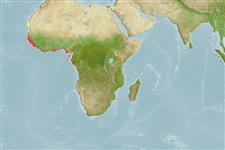Classification / Names
Common names from other countries
Main reference
Size / Weight / Age
Max length : 200 cm TL male/unsexed; (Ref. 57402); common length : 150 cm TL male/unsexed; (Ref. 3659); max. published weight: 75.0 kg (Ref. 7386)
Environment
Marine; freshwater; brackish; demersal; depth range 15 - 55 m (Ref. 10799)
Climate / Range
Tropical, preferred 27°C (Ref. 107945); 22°N - 5°S, 26°W - 13°E (Ref. 57343)
Distribution
Short description
Dorsal
spines
(total): 9;
Dorsal
soft rays
(total): 12-13;
Anal
spines: 3;
Anal
soft rays: 11 - 12. Diagnosis: detached pectoral filaments short, only slightly longer than upper pectoral fin; base of anal fin as long as base of 2nd dorsal fin; body moderately elongate and compressed, its height comprised 4.0 to 4.5 times in standard length; snout very short, blunt and prominent; mouth inferior; maxillary bone distinctly widened at its end, reaching largely past eye; 2 widely separated dorsal fins, 1st with 8 flexible spines, 2nd with one flexible spine and 12-13 soft rays; 2nd dorsal fin and anal fin bases nearly equal; pectoral fin inserted very low on body, threadlike filaments 4 in number, generally somewhat longer than upper part of fin; scales ctenoid; head scaly (Ref. 57402).
Coloration: body uniformly silvery, greyish on back, shading to whitish ventrally; fins yellow or grey; a dark blotch often present on gill cover (Ref. 57402).
IUCN Red List Status (Ref. 115185)
Threat to humans
Harmless
Human uses
Fisheries: commercial; gamefish: yes
More information
Common namesSynonymsMetabolismPredatorsEcotoxicologyReproductionMaturitySpawningFecundityEggsEgg development
ReferencesAquacultureAquaculture profileStrainsGeneticsAllele frequenciesHeritabilityDiseasesProcessingMass conversion
Tools
Special reports
Download XML
Internet sources
Estimates of some properties based on models
Phylogenetic diversity index
PD50 = 0.5000 many relatives (e.g. carps) 0.5 - 2.0 few relatives (e.g. lungfishes)
Trophic Level
4.0 ±0.66 se; Based on food items.
Resilience
Medium, minimum population doubling time 1.4 - 4.4 years (K=0.34(?); assuming tm=3-4)
Vulnerability
High to very high vulnerability (69 of 100)
Price category
